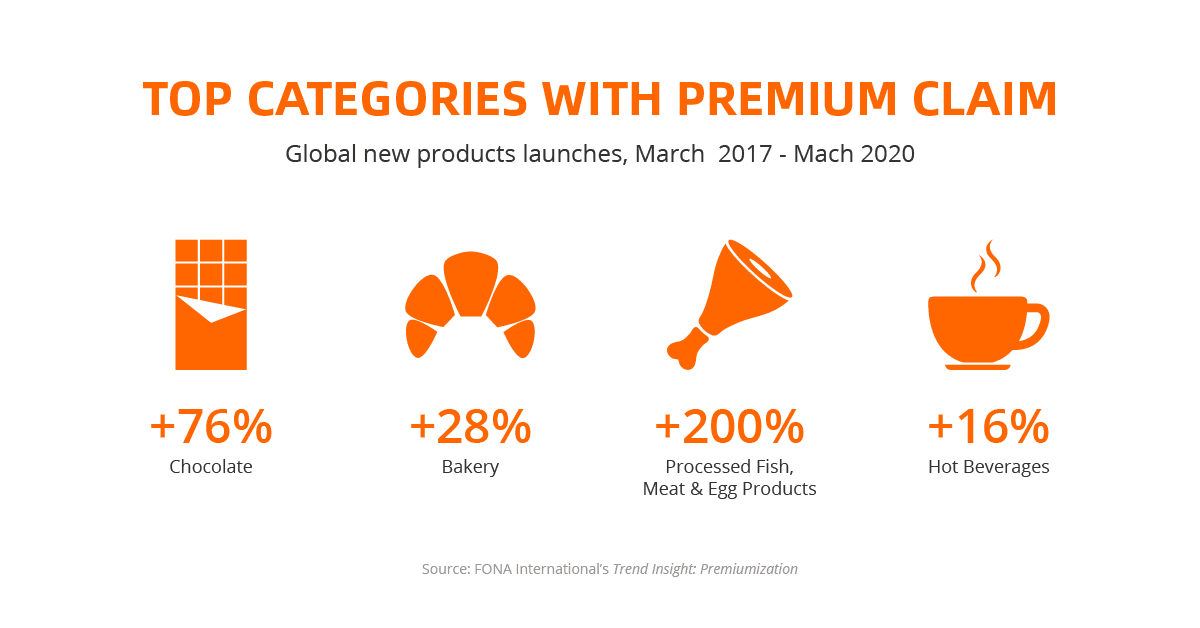

This article was adapted from FONA International’s Trend Insight: Premiumization
Premiumization, making a product appeal to consumers by emphasizing its superior quality and exclusivity, has become an increasingly popular way for brands to innovate, paving the way for new unique flavors and sensations. Premium products can be a way for consumers to reward themselves as an act of self-care, sometimes justifying a higher price point.
In addition, as the world recovers from the COVID-19 pandemic, enjoying the good parts of life through premiumization is predicted to become an even greater focus in the coming years. According to a recent report published by MarketWatch, the premium chocolate market is expected to grow at a compound annual growth rate (CAGR) of 7.28% from 2018 to 2022.
With self-care mentalities growing in popularity, and the consumer perception of “high quality is more healthy,” here are a few ways premium may affect your brand.
Multifaceted and varied in form and flavor, premium products must be justified by their ingredients, benefits, or taste. Whether it’s a limited-time flavor or new texture or sensation, premium products must deliver on uniqueness. Treating yourself with unique premium products became even more important during the COVID-19 pandemic when consumers talked about “me-time” as essential to their well being.
Certain categories have seen greater growth in premium products than others. Processed fish, meat, and egg products saw a 200% increase in premium products from March 2017 to March 2020, while hot beverages only saw a 16% increase.

The top two characteristics of premium products according to consumers are exceptional quality (54%) and superior performance (46%). Gen Z and millennials are more likely to cite superior design and customer service as premium features as well. The health and wellness movement has also influenced premium purchasing, with 66% of consumers making a premium purchase to switch to healthier products and 52% of consumers claiming that purchasing a premium product makes them feel good.
Millennials are currently the largest buying group of premium products, and younger consumers overall make premium purchases based on emotional reasons far more often than baby boomers. This emotion-based buying could be linked to the growing self-care trend. A self-care indulgence makes higher prices more acceptable as they align naturally with the “treat yourself” state of mind.
Looking ahead, brands should prepare for the rise of Gen Z by leveraging personalization as premium. This generation is willing to pay more for products that highlight their unique individuality. Businesses should consider introducing premium products to their brand to attract these younger consumers.
As millenials and Gen Z continue to grow in purchasing power, there are more opportunities to innovate premium products highlighting personalization and unique flavor. The COVID-19 pandemic also led to consumers seeking comfort and savoring enjoyment where they can. When launching premium food and drink, the most important characteristics are quality and performance. Premiumization is constantly developing, and this trend isn’t going away any time soon.
Hear more on premiumization and other food trends from the experts at FONA International, and other Food & Beverage keynote speakers, at the Alibaba.com US Food & Beverage Online Trade Show. Register as a buyer here.
It’s a challenging time for small CPG businesses, but finding the right partners and distributors are the key to success. Watch our fireside chat to hear CEO of Stroop Club Chantal Piët share how her small Austin-based business navigates the complex world of B2B distribution with the help of LTA International and Alibaba.com. You can view some of our other fireside chats here.
Use a delivery service to distribute your food products. That way you can spend more time focusing on marketing and product development.


